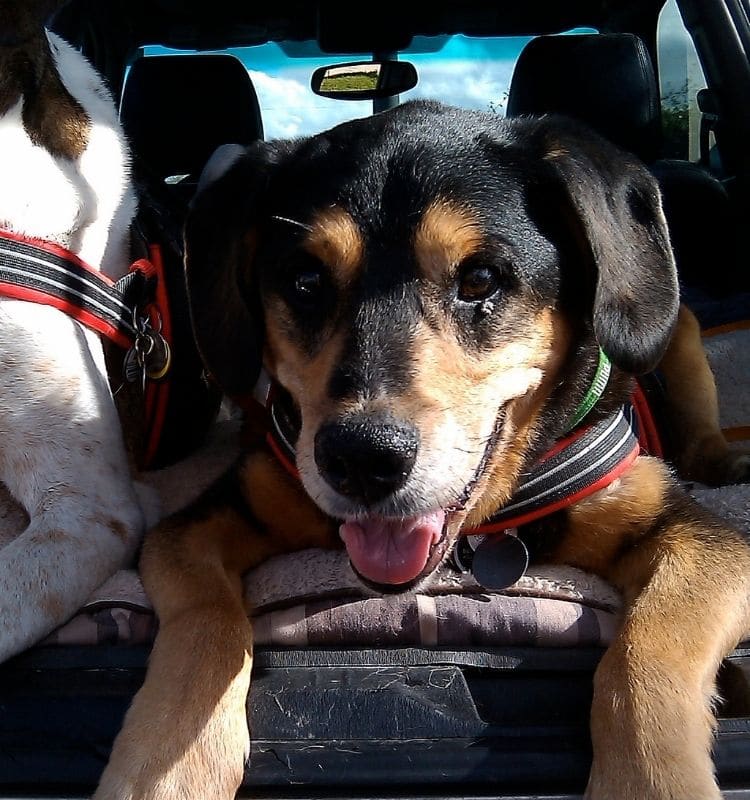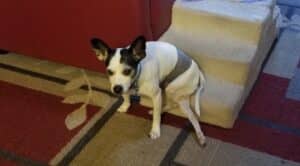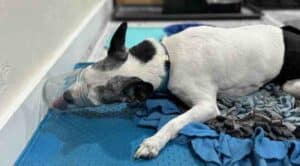A few days ago, Travis, Harley and I went for a walk at a favorite local park. I love this place because it has plenty of wide open spaces that are free of dangerous cacti, rodent holes of unusual size and mountainous curbs. This was an especially wonderful day because it felt like we had this 56-acre paradise to ourselves.
Travis was having a great day, sniffing around but keeping a decent pace with an occasional trot, bouncing ears and jangling tags. As we walked along, he would bump into my leg with his shoulder or nose (we need to check his alignment, he pulls to the right) then overcorrect wildly in the opposite direction. Sometimes, he’d brush my leg gently and correct just enough to stay on course. This contrast got me thinking.
I like to get lost in thought while I’m with Travis—really lose myself in his world, a dog’s world, and try to relate to him on his terms, not my human terms. When I’m able to do this (without losing track of Harley and his position relative to all the other dogs in the park), I always learn something from Travis. Today his lesson for me was clear. And he’d engaged a very powerful ally: my mother.
Walking and bumping with Travis invoked a memory that hadn’t surfaced in many years. When I was in college, I had a dog named Virginia, Gin for short. Gin stayed home with my parents while I was away at school and during that time developed a strong relationship with my mother. Gin was my mother’s constant companion, especially after we kids had left the nest and our father passed away a few years later. As Gin aged, she developed a retinal degeneration similar to what Travis has experienced during the last six months. She, too, lost her vision and struggled to find her way in a suddenly dark, dark world.
Gin had been blind for many months when The Strays walked through the yard that day. Mom, at first fearful for Gin’s safety, watched intently as the two dogs approached Gin, did their introductions and circled around her. They brushed her on each side, licked her face and play-bowed to her. A Stray on each side of Gin, the three dogs suddenly began to run through the yard. The Strays kept her safe from the trees, the bushes, the flower beds and even the mailbox and the car. The three of them galloped and changed direction in unison, like a flock of birds swooping from one perch to another. The three dogs ran and played until Gin tired and The Strays returned her to the porch. As quickly as they had come, they were gone. Mom had never seen the pups before that and never saw them again. But for that afternoon, they had removed the darkness from Gin’s eyes, given her the chance to run again and feel the breeze through her coat. Gin died a few months after this visit, but my mother never stopped telling that story.
I hadn’t thought of this story for many years but it’s the perfect teaching tool for how to be the seeing-eye person Travis needs. He needs me to give him enough space to explore his world. He doesn’t need firm, reactionary direction. He needs me to focus on being with him, in his bubble, concentrating on the dance he’s leading. He’s trusting me to keep him safe from three-inch bougainvillea thorns, tree trunks and craters that could swallow a MINI Cooper.
As we continued to walk and I pondered the message of Gin’s story, I tried something different. I dropped Travis’s leash. We walked down the soccer field as equals. I used the touches I imagined the two dogs had used with Gin. I grazed his shoulder with my leg and ran a quick finger along the back of his ear—just enough to have him turn his head and re-direct his body, but not break stride. As he followed his nose across midfield, I practiced skimming his ribs with my leg to remind him I was close beside him and watched his subtle reaction to my touch.
I was lost in his world but what I found will serve us both for what I hope is a long time to come: I’m learning to dance.






